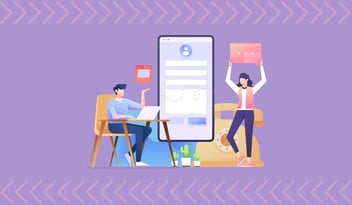
For marketers, it’s never been more important to produce high-quality content that resonates with target audiences. The question is where to find the time while you are juggling day-to-day tasks. Wouldn’t it be nice to have an assistant to help you brainstorm ideas for your blog or social media posts? We get it, not everyone has the luxury of hiring an assistant to help them out. Thankfully, with the surge of various AI assistants like ChatGPT, content creators now have that helper they have been dreaming of right on their web browsers. However, like with most tools, understanding how to use it effectively is essential.
We have compiled a list of tips and tricks to help you effectively generate unique and personalized content ideas, create attention-grabbing headlines, and refine your messaging and tone to ensure increased readability and engagement.
Generating Content Topics
One of the most challenging aspects of content creation is coming up with fresh and engaging topic ideas. As a content creator, you need to produce content that provides value to your target audience while also being interesting enough to stand out from the crowd. With ChatGPT, you can generate a list of related topics by giving it a broad topic or keyword. It uses machine learning algorithms to generate natural language responses based on a given input. By exploring different angles and perspectives on the topic, you can craft content that is informative, valuable, and unique. Here are some tips for using ChatGPT to generate content topics:
Ask what’s relevant to your target audience.
Create prompts to dive into your target audience's interests and needs. For example, you could ask, "What topics are popular among B2B tech software marketers?" or, "What are effective topics for targeting millennial skincare consumers?" The more specific, the better. Prompts like these can help you create ideas that speak to your audience to drive higher engagement.
Provide context about your industry and niche.
More context and specific information will make ChatGPT’s responses more engaging. We found that sharing context in paragraph form first and then asking for content ideas worked well. There are many ways to interact with the platform, but we found that having a basic conversation works very well. Try something like this:
Pretend you are a content writer. You work in the ______ industry, and your ideal audience is _____. They are interested in ______ and _____. Your goal is to _____. Please come up with 5 content ideas around _____.”
Refine your prompts based on ChatGPT’s suggestions.
You can use the initial suggestions ChatGPT generates as a starting point and then refine your prompts to get more specific and relevant ideas. For instance, if ChatGPT suggests "5 content ideas for social media marketing" as a topic, you could then ask for specific content ideas on a particular platform or ask for more detail about a specific content idea that you like. You can also use ChatGPT to run market research on your ideal audience. At a high level, we found ChatGPT can help identify popular topics and trends, allowing you to create content that is both relevant and fun.
Personalizing Your Content
Personalization is a crucial aspect of effective content marketing. When you provide demographic or psychographic data about your audience, ChatGPT can generate content ideas that speak more directly to your audience, foster a deeper connection, and encourage greater engagement. By developing a content creation strategy that is data-driven and personalized, you can establish your company as a thought leader, increase brand awareness, and drive traffic.
Creating Attention-Grabbing Headlines
An effective, SEO-friendly headline can make all the difference in attracting users’ attention and encouraging them to click through and engage with your content. Start generating alternative headline ideas by inputting a working title or a few keywords related to your content. Then, try these tips to create attention-grabbing headlines:
Explore variations.
Once you have an initial headline idea, use ChatGPT to generate a list of alternative headlines. Combine various parts together and play around with the suggestions until you hit on one you like.
Experiment with different headline structures.
Several headline structures, such as listicles, how-tos, and questions, have been proven to be effective in catching people's attention. Experiment with some of these structures to see what fits best with your content.
Add powerful words to elicit emotion.
To make your headlines more effective at grabbing your audience’s attention, ask ChatGPT to list emotional and power words. For instance, you can ask ChatGPT for adjectives or verbs that elicit strong emotions. Using words like “shocking,” “amazing,” captivate,” or “infuriate” in your headlines can trigger an emotional response that encourages users to click through to your content.
Refining Messaging and Tone
Once YOU have written a content draft (combining your intelligence with ChatGPT’s ideas), ChatGPT can offer suggestions to refine sentences or entire paragraphs. As you know, the tone of a message is equally important as the content itself. We were amazed at how well the tool assists in shaping tone to resonate with a brand identity and speak directly to a specific audience. We experimented with various tones like conversational, formal, humorous, persuasive, authoritative, empathetic, and optimistic. For a bit of amusement, we even asked it to rephrase paragraphs in the style of notable figures like ips to improve messaging and tone.
Identify your audience’s preferences.
ChatGPT can analyze your target audience's communication styles by generating content samples that cater to their preferences. Provide specific details about your audience, and ChatGPT will suggest the most suitable tone and style for your content.
Maintain consistency.
Maintain a consistent tone across your content by asking for rephrasing suggestions that align with your chosen tone. Specify your desired tone and ask ChatGPT to reword sentences or paragraphs to match.
Adapt tone for different platforms.
Inform ChatGPT about the platform you are targeting, and it will provide content suggestions that are appropriate for that specific channel. For instance, you can ask for casual language for social media or formal language for a white paper.
Use active voice.
Convert passive voice sentences into active voice. Submit a sentence you wrote and simply ask it to rewrite the sentence using active voice. Doing so can make your content more engaging and comprehensible.
Optimizing for Search
Effective content marketing relies heavily on search engine optimization (SEO). While there are many great SEO tools, ChatGPT can also assist you by suggesting relevant keywords and phrases for your content and how to structure the content to enhance search ranking. This will allow you to create high quality content that is both informative and optimized for search engines, resulting in increased visibility and reach. Try these tips to optimize your content for search engines:
Generate keyword ideas.
Keywords are an essential component of SEO, as they help search engines understand the content of a webpage. Use ChatGPT to generate keyword ideas that are relevant to your content and industry. For instance, if you're writing an article about digital marketing, ask ChatGPT for relevant keywords. It’s likely to come up with suggestions such as "SEO," "social media marketing," and "content marketing."
Analyze your content's readability.
Readability is a crucial factor in SEO, as search engines prefer content that is easy to read and understand. Use ChatGPT to analyze your content and suggest changes to improve its readability. For example, ChatGPT can suggest using shorter sentences, simplifying your vocabulary, or breaking up your content into smaller paragraphs. You can also use it to analyze your keyword density. Here are some examples of how you might phrase your request:
- "I've drafted a blog post on vegan recipes. Can you help me understand if it's easy to read and comprehend?"
- "We've created a product description for our new tech product. Could you assess its readability and suggest improvements if necessary?"
Suggest internal and external link examples.
Internal and external links are also important for SEO, as they help search engines understand the relationships between different pages and websites. Use ChatGPT to suggest relevant internal and external links for your content. For example, if you’re wrting a blog post on ‘Deep Learning in Healthcare’, you could ask ChatGPT to generate suitable internal and external link ideas for this content. Here are a few example prompts you could use:
- "I'm writing an article about the environmental impact of electric cars. Can you suggest some internal and external links I can include?"
- "We're creating a blog post about the latest advancements in artificial intelligence. What internal pages from our website and external resources could we link to?"
Optimize content.
Once you have identified your target keywords, ChatGPT can help you optimize your content for those keywords. You can use ChatGPT to generate topic ideas, write meta descriptions, and create compelling headlines that include your target keywords.
Making It Original
Although AI assistants like ChatGPT can be valuable tools, it's crucial to recognize that they cannot replace the human element of content creation. Instead, consider them as a resource to complement your own creativity and expertise rather than relying on them entirely.
ChatGPT is a remarkable asset for marketers and content creators seeking to generate innovative ideas, craft captivating headlines, and polish their messaging and tone. With its ability to produce natural language responses based on given inputs, ChatGPT can help marketers develop content that not only resonates with their target audience but also is informative, valuable, and distinctive. By implementing the strategies and advice above, you can harness the power of ChatGPT to create standout content that drives engagement.
Happy content writing!


